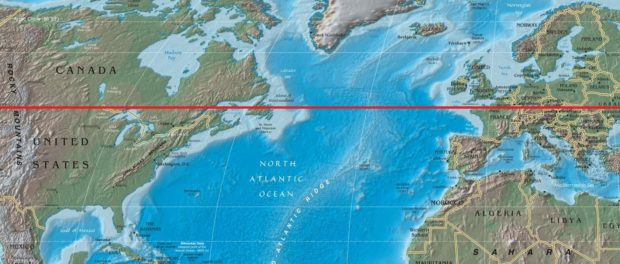1818: An Uneasy Border & Other Quebec Curios
Part of “The Canadas in Britain”, 1792-1827
Some people claim that the American-Canadian border was officially created just before the boom of American migration along the Oregon and Californian trails, in the 1840s. However, before people attempted to caulk wagons and died of dysentery as a result, there was one treaty, in October 1818, that would first establish the semblance of a border: the 1818 Anglo-American treaty.
The Anglo-American treaty had Britain and the United States swap territory, fishing rights, and settled a dispute in which America claimed that the British had stolen slaves and demanded compensation. Regarding the dispute on slaves, it is unfortunate to note once more that slaves were not seen as human beings back then and that Britain did indeed provide compensation instead of returning the slaves; Britain would later abolish slavery in most of the British Empire in 1833. America, like its French neighbours, would get fishing rights off the coasts of Newfoundland and gained some territory that would later become parts of North Dakota. One of the most important decisions, however, was the establishment of the border between the United States and British territory as the 49th Parallel, a line roughly at the border of Upper Canada all the way to the Rocky Mountains. The border already long established between the former Thirteen Colonies and the former New France would remain the same. A border between the Rockies to the Pacific, however, would remain to be drawn.
How does one exactly delimitate the border, anyhow, other than on paper? You send down surveyors. However, when the surveyors come from both Canada and the United States, and the question of paying these surveyors to put down markers to mark the border comes up, you can get into a very heated discussion. Indeed, border disputes would not end with the 49th Parallel. American expansionism, largely fuelled by the doctrine of Manifest Destiny, was to start up. Western expansion beyond the Rockies would fuel more border disputes with Canada, with the Americans hoping to claim land all the way up north to Alaska. In the meanwhile, however, for British North America, the 49th Parallel would have to do.
For the Canadas, this treaty might mean very little to the average person on the street. As the unity of war that briefly brought the two Canadas together subsided, tensions would start brewing up between the two neighbours once more. Political and social uneasiness would eventually blow up into a full rebellion and cause consequences that would once again threaten the language and culture of Lower Canada.





